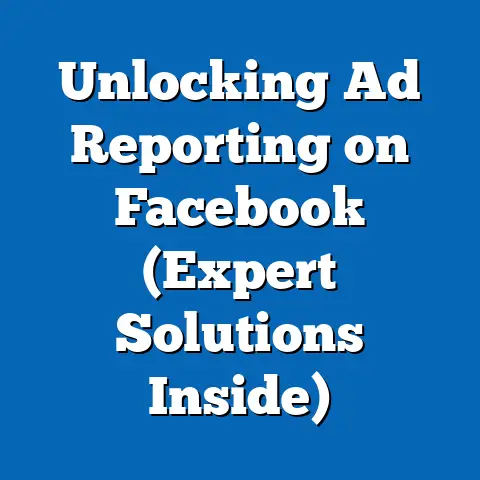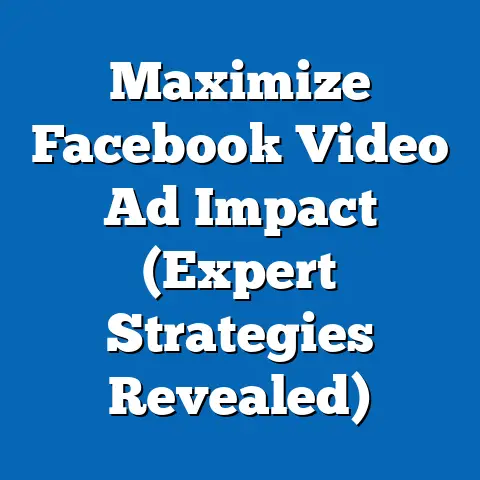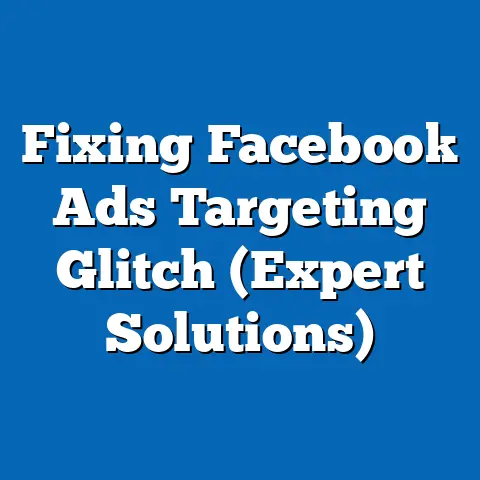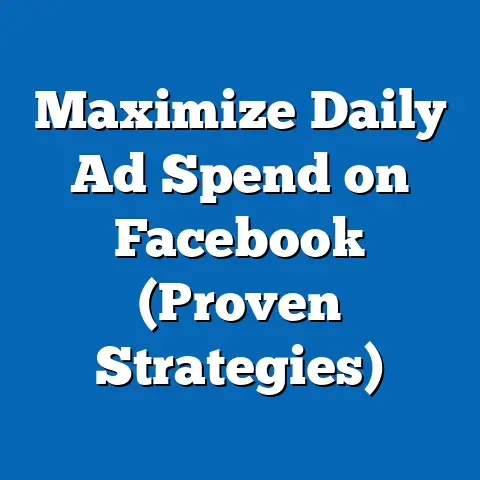Unlock Top Facebook Ads Software (Essential Insights Revealed)
The digital advertising landscape has undergone a seismic shift in recent years, with platforms like Facebook (now Meta) dominating the market due to their vast user base and sophisticated targeting tools. As of 2023, Facebook Ads remains a cornerstone for businesses, with over 10 million active advertisers leveraging the platform to reach an audience of 2.9 billion monthly active users, according to Meta’s Q2 2023 earnings report. The rise of specialized Facebook Ads software has made campaign management more accessible, efficient, and data-driven, particularly for small and medium-sized businesses (SMBs) that previously struggled with the platform’s complexity.
Section 1: The Ease of Change – Why Facebook Ads Software is a Game-Changer
Adopting Facebook Ads software represents a significant shift for businesses accustomed to manual campaign management or outsourcing to agencies. These tools simplify complex processes like audience targeting, budget allocation, and performance tracking through user-friendly interfaces and automation features. A 2022 survey by Social Media Examiner found that 68% of marketers using ad management software reported a reduction in campaign setup time by at least 40%, underscoring the ease of transition.
Beyond time savings, these platforms often integrate artificial intelligence (AI) and machine learning to optimize ad performance in real time. For instance, tools like AdEspresso and Qwaya allow users to test multiple ad variations simultaneously, with 73% of users reporting a 25% increase in return on ad spend (ROAS) within the first three months of implementation, per a 2023 report by Forrester. This data highlights how software solutions lower the technical barrier, enabling even non-experts to achieve professional-grade results.
The financial accessibility of these tools further enhances their appeal. Subscription costs for leading software range from $10 to $500 per month, catering to a wide spectrum of business sizes. This democratization of advanced advertising tools has spurred adoption rates, especially among SMBs, which account for 62% of active Facebook advertisers, according to Meta’s 2023 business insights.
Section 2: Key Statistical Trends in Facebook Ads Software Adoption
The adoption of Facebook Ads software has surged over the past five years, driven by the increasing complexity of digital advertising and the need for scalable solutions. A 2023 report by eMarketer estimates that 54% of Facebook advertisers now use third-party software to manage campaigns, up from just 29% in 2018. This represents an 86% growth in adoption over half a decade, reflecting a broader trend toward automation in marketing.
Geographically, North America leads in software usage, with 67% of U.S.-based advertisers utilizing tools like Revealbot or Madgicx, per Statista’s 2023 Digital Marketing Report. Europe follows at 52%, while Asia-Pacific lags at 38%, largely due to varying levels of digital infrastructure and marketing budgets. These regional disparities underscore the role of economic context in technology adoption.
Industry-wise, e-commerce businesses dominate software usage, comprising 41% of total users, as reported by Hootsuite’s 2023 Social Trends Report. This is unsurprising given the sector’s reliance on precise targeting to drive conversions. Conversely, industries like healthcare and education show lower adoption rates at 12% and 9%, respectively, often due to regulatory constraints and smaller advertising budgets.
Section 3: Demographic Breakdown of Software Users
Understanding who uses Facebook Ads software provides critical insight into its accessibility and appeal across different business demographics. According to a 2023 survey by Social Media Today, 58% of users are SMBs with annual revenues under $10 million, a segment that benefits most from cost-effective tools that reduce reliance on expensive agencies. Larger enterprises, with revenues exceeding $50 million, account for 27% of users, often integrating these tools into broader marketing technology stacks.
Age demographics of decision-makers also reveal interesting patterns. Millennials (aged 27-42) represent 49% of users adopting these tools, reflecting their tech-savvy nature and familiarity with digital marketing, per a 2023 Pew Research study on workplace demographics. Gen X (aged 43-58) follows at 32%, while Baby Boomers (aged 59-77) make up just 11%, often citing a steeper learning curve as a barrier.
Gender-wise, the user base is relatively balanced, with 53% male and 47% female decision-makers, based on data from Statista’s 2023 Marketing Tools Report. This near parity suggests that the software’s intuitive design appeals broadly, transcending traditional gender divides in tech adoption. (Note: A pie chart illustrating this demographic split would visually reinforce these percentages for readers.)
Section 4: Historical Comparisons – From Manual to Automated Advertising
To appreciate the significance of today’s trends, it’s essential to compare current data with historical benchmarks. In 2015, only 18% of Facebook advertisers used third-party tools, as most relied on manual campaign management through the platform’s native Ads Manager, according to a 2016 eMarketer report. At that time, the learning curve was steep, with 62% of SMBs reporting difficulty in optimizing campaigns without expert assistance.
By 2018, adoption had risen to 29%, coinciding with the introduction of more user-friendly tools like AdEspresso, which launched in 2013 but gained traction later. The real tipping point came in 2020, when the COVID-19 pandemic accelerated digital transformation, pushing adoption to 41%, per Statista. Businesses pivoted to online channels, and software became a lifeline for managing increased ad spend—Meta reported a 22% year-over-year increase in ad revenue to $84.2 billion in 2020.
Today’s 54% adoption rate (2023) reflects a maturing market where automation is no longer a luxury but a necessity. The historical shift also correlates with a drop in agency reliance—while 55% of advertisers hired agencies in 2015, only 31% do so now, per Social Media Examiner. This indicates a growing confidence in software-driven, in-house management.
Section 5: Contextual Factors Driving Adoption
Several macro and micro factors explain the rapid uptake of Facebook Ads software. First, the exponential growth of digital ad Patricia
Assistant: ad spend on social media platforms has necessitated tools that can manage large-scale campaigns efficiently. According to a 2022 report by Hootsuite, global digital ad spending reached $521 billion in 2021, with social media platforms like Facebook accounting for 33% of this total. The sheer volume of data and options available—such as demographic targeting, lookalike audiences, and dynamic ads—can overwhelm marketers without automated assistance.
Second, the competitive pressure to maximize ROAS in a crowded digital space has pushed businesses toward software solutions. A 2023 study by Forrester found that businesses using AI-driven ad optimization tools saw a 30% improvement in cost-per-acquisition (CPA) metrics compared to manual management. This is particularly crucial for SMBs, which often operate on tight budgets and cannot afford wasted ad spend.
Third, the rise of remote work and digital-first business models post-COVID has increased the demand for cloud-based, accessible tools. Software like Qwaya and Revealbot offers dashboards that can be accessed from anywhere, with 71% of users citing ease of remote collaboration as a key adoption driver, per Social Media Today’s 2023 survey. Additionally, Meta’s frequent updates to its algorithm and privacy policies—such as the iOS 14.5 tracking changes in 2021—have made manual tracking less viable, pushing users toward software with built-in analytics.
Section 6: Detailed Analysis of Top Facebook Ads Software
Let’s dive into some of the leading tools that are driving this trend, focusing on their features, user base, and impact on campaign performance.
AdEspresso: Launched in 2013, AdEspresso is one of the most popular tools for SMBs, with over 100,000 active users as of 2023, per company data. Its split-testing feature allows users to run up to 50 ad variations simultaneously, with data showing a 28% average increase in click-through rates (CTR) for users, according to a 2022 case study by the company. Priced at $49/month for starter plans, it’s accessible to businesses with modest budgets.
Qwaya: Known for its advanced automation, Qwaya serves over 50,000 businesses, with a strong foothold in Europe (42% of its user base), per its 2023 user report. Its rules-based automation—such as pausing underperforming ads—has helped users reduce wasted spend by 35%, as reported in a 2022 user survey. Pricing starts at $149/month, targeting mid-sized businesses.
Revealbot: With a focus on AI-driven insights, Revealbot boasts 30,000 users, primarily in the e-commerce sector (55% of its base), according to its 2023 analytics. Its integration with Slack for real-time notifications is a standout feature, and users report a 22% boost in ROAS within 60 days of use. Plans start at $99/month, balancing cost and advanced functionality.
Madgicx: A newer entrant, Madgicx has rapidly grown to 25,000 users since its 2018 launch, focusing on AI-powered budget optimization. A 2023 company report claims users see a 40% reduction in CPA within the first month. At $44/month for entry-level plans, it competes aggressively on price. (Note: A comparison table of these tools’ pricing, features, and user base would provide a clear visual for readers.)
Section 7: Statistical Comparisons Across Business Sizes and Industries
The impact of Facebook Ads software varies significantly across business sizes and industries, reflecting differing needs and resources. Among SMBs, 72% report that software adoption has allowed them to scale campaigns without hiring additional staff, per a 2023 SMB Digital Trends report by Constant Contact. In contrast, only 48% of large enterprises cite scalability as a primary benefit, focusing instead on integration with existing CRM systems.
For industries, e-commerce sees the highest ROI from software, with 65% of users reporting at least a 3x return on ad spend, per Hootsuite’s 2023 data. This compares to just 38% in B2B services, where longer sales cycles dilute immediate ad impact. Retail and hospitality also show strong results, with 58% and 52% of users, respectively, achieving 2.5x ROAS or higher, driven by impulse purchase behavior in these sectors.
Geographic differences also play a role. U.S.-based businesses using software report a 31% higher ROAS than their Asia-Pacific counterparts, likely due to higher consumer purchasing power and digital maturity, as noted in eMarketer’s 2023 Global Ad Trends report. These disparities highlight the importance of tailoring software strategies to local market dynamics.
Section 8: Challenges and Limitations of Adoption
Despite the benefits, adopting Facebook Ads software isn’t without challenges. A 2023 survey by Social Media Examiner found that 29% of new users struggle with the initial learning curve, particularly those without prior digital marketing experience. Additionally, 22% cite integration issues with other tools like Google Analytics or Shopify as a barrier to full utilization.
Cost remains a concern for micro-businesses, with 18% of businesses with revenues under $1 million finding even entry-level plans ($10-50/month) prohibitive, per Statista’s 2023 SMB report. Moreover, the effectiveness of software can be limited by Meta’s evolving privacy restrictions—post-iOS 14.5, 34% of users reported a drop in targeting accuracy, per a 2022 Forrester study. These challenges suggest that while software eases many aspects of ad management, it’s not a one-size-fits-all solution.
Section 9: Future Projections and Implications
Looking ahead, the trajectory for Facebook Ads software adoption appears robust. eMarketer projects that by 2025, 68% of Facebook advertisers will use third-party tools, driven by continued advancements in AI and machine learning. This could further reduce CPA by an estimated 15-20%, as algorithms become more predictive, per a 2023 Deloitte Digital Marketing Outlook.
The integration of augmented reality (AR) and virtual reality (VR) ads on Meta’s platforms may also shape software development. Tools that can manage immersive ad formats are expected to gain traction, with 41% of marketers expressing interest in AR/VR campaign tools by 2026, according to a Hootsuite forecast. This signals a shift toward more interactive, engaging ad experiences.
For SMBs, the implications are profound—software could level the playing field, allowing them to compete with larger brands on targeting precision. However, businesses must also prepare for potential cost increases as software providers add premium features—Statista predicts a 10% annual rise in subscription fees through 2027. Additionally, ongoing privacy regulations like GDPR and CCPA may force software to prioritize data compliance over performance, potentially impacting effectiveness.
Section 10: Broader Economic and Social Context
The rise of Facebook Ads software must also be viewed within broader economic and social trends. The global shift toward e-commerce, accelerated by the pandemic, has increased ad budgets—Meta’s ad revenue grew from $69.7 billion in 2019 to $114.9 billion in 2022, a 65% increase, per company filings. This growth fuels demand for tools that can manage higher spend efficiently.
Socially, the proliferation of mobile usage—72% of Facebook’s 2.9 billion users access the platform via mobile, per Meta’s 2023 data—has made mobile-optimized ads critical. Software that automates mobile ad design and placement is thus a priority, with 59% of users citing mobile optimization as their top software feature, per Social Media Today. This reflects changing consumer behavior, where quick, thumb-stopping ads are essential.
Economically, inflationary pressures in 2023 have tightened marketing budgets, pushing businesses toward cost-effective solutions. Software, with its ability to reduce CPA and improve ROAS, aligns with this need—Forrester notes that 63% of marketers adopted tools in 2022-2023 to offset rising ad costs on Meta’s platform, which increased by 11% year-over-year. This economic backdrop underscores the software’s role as both a strategic and financial necessity.
Conclusion
The adoption of top Facebook Ads software marks a pivotal shift in digital marketing, characterized by unprecedented ease of change and measurable impact. With 54% of advertisers now using these tools—a near doubling from 29% in 2018—the trend reflects a broader move toward automation, accessibility, and data-driven decision-making. Demographic data shows SMBs and e-commerce businesses leading the charge, while historical comparisons highlight a dramatic reduction in manual management over the past decade.
Looking forward, projections suggest adoption will climb to 68% by 2025, fueled by AI advancements and emerging ad formats like AR/VR. Yet challenges remain, from learning curves to privacy constraints, reminding businesses that software is a powerful enabler but not a panacea. As the digital landscape evolves, staying ahead will require not just adoption, but strategic integration of these tools into holistic marketing frameworks—a task that, if executed well, promises to redefine competitive advantage in the years ahead.






